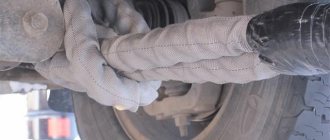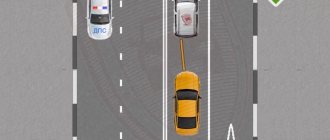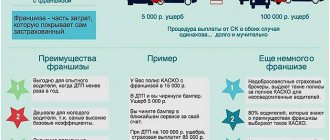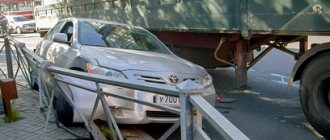Good morning, dear reader. Every driver has certainly been involved in towing a car or other vehicle.
In practice, this leads to the fact that few drivers know the rules of towing and, if necessary, tow without violating traffic rules.
Let me remind you that in the Road Traffic Regulations the term “towing” can mean both towing a trailer and towing a vehicle. This article will focus only on towing vehicles.
Towing regulations are covered in the Towing of Motor Vehicles chapter of the Highway Code, but the term towing can also be found in other chapters.
In this article, we will focus on the different types of towing and their associated regulations:
- Towing a vehicle using a flexible hitch.
- Rules for towing with a flexible hook.
- Towing on a rigid hook.
- Principles of towing with a rigid hitch.
- Partial towing.
- Partial loading rules.
Rigid coupling
Towing on a rigid hitch is carried out using a special design.
Unlike a conventional cable, it ensures a constant distance between cars. That's a plus. Typically, this method is used for towing heavy equipment and trucks. And quite rarely - passenger cars. The usual towing eye of a modern car simply cannot withstand a rigid hitch - it can break off with regular jerks. And it’s unlikely that anyone will carry a device for rigid coupling of cars with them in reserve. Towing on a rigid hitch is carried out using a special design. Unlike a conventional cable, it ensures a constant distance between cars. That's a plus. Typically, this method is used for towing heavy equipment and trucks. And quite rarely - passenger cars. The usual towing eye of a modern car simply cannot withstand a rigid hitch - it can break off with regular jerks. And it’s unlikely that anyone will carry a device for rigid coupling of cars with them in reserve.
Instructions for labor protection when towing, coupling and uncoupling vehicles
Instructions for labor protection when towing, coupling and uncoupling cars 1. General labor protection requirements 1.1 Drivers or specially appointed persons who have passed a medical examination, introductory briefing, initial briefing, on-the-job training and internship, and inspection are allowed to tow, couple and uncouple cars. knowledge of labor protection requirements with appropriate qualifications. 1.2 Personnel performing work on towing, coupling and uncoupling vehicles are obliged to: 1.2.1 Perform only the work specified in the work instructions. 1.2.2 Comply with internal labor regulations. 1.2.3 Correctly use personal and collective protective equipment. 1.2.4 Comply with labor protection requirements. 1.2.5 Immediately notify your immediate or superior manager about any situation that threatens the life and health of people, about every accident that occurs at work, or about a deterioration in your health, including the manifestation of signs of an acute occupational disease (poisoning); 1.2.6 Receive training in safe methods and techniques for performing work and providing first aid to victims at work, instructions on labor protection, and testing of knowledge of labor protection requirements. 1.2.7 Undergo mandatory periodic (during employment) medical examinations (examinations), as well as undergo extraordinary medical examinations (examinations) at the direction of the employer in cases provided for by the Labor Code and other federal laws. 1.2.8 Be able to provide first aid to victims of electric current, laser radiation and other accidents. 1.2.9 Be able to use primary fire extinguishing agents. 1.3 When towing, coupling and uncoupling vehicles, exposure to the following dangerous and harmful production factors is possible: - moving machines and mechanisms; — increased or decreased air temperature in the working area; — increased air humidity; — sharp edges, burrs and roughness on the surfaces of workpieces, tools and equipment; — insufficient or excessive illumination of workplaces; — the appearance of explosive, flammable and toxic environments in the work area; - physical overload. 1.4 When carrying out work on towing, coupling and uncoupling a car, you must know and remember that accidents can most often occur when: - working with an unreliably braked car or trailer; - when an employee is between a towing vehicle with a running engine and a trailer or towed vehicle during coupling or uncoupling; — uncoordinated actions of the drivers of the towing and towed vehicles; - using random objects as a tug. 1.5 Each employee must be provided with special clothing, special footwear and other personal protective equipment in accordance with the Standard Industry Standards for the free issuance of special clothing, special footwear and other personal protective equipment and the Collective Agreement. 1.6 In cases of injury or illness, you must stop work, notify the work manager and contact a medical facility. 1.7 For failure to comply with this instruction, those responsible will be held accountable in accordance with the legislation of the Russian Federation. 2. Labor protection requirements before starting work 2.1 Put on special clothing and special shoes. 2.2 Prepare the tools and devices necessary for the work and make sure they are in good working order. Check the serviceability of trailers and their towing devices. 2.3 Remove unauthorized persons from the work area. 2.4 Report all shortcomings and malfunctions of tools and devices found during inspection to the work manager so that measures can be taken to eliminate them. 3. Labor safety requirements during work 3.1 Before coupling and uncoupling a car and a trailer (semi-trailer), the latter must be braked with a parking brake and wheel chocks (chocks) placed under the wheels. 3.2 When a tractor-trailer vehicle is being delivered to a towed vehicle, people are not allowed to be between this vehicle and the moving vehicle. 3.3 Coupling or uncoupling should be done on a flat horizontal surface, and the longitudinal axis of the semi-trailer being coupled should coincide with the longitudinal axis of the tractor vehicle. 3.4 Before coupling a trailer (semi-trailer), the driver must make sure that: - connecting hoses and electrical wires do not interfere with coupling; — the sides are closed; — the fifth wheel coupling, king pin and their fastenings are in good working order; — the front part of the semi-trailer is positioned in height so that when coupling, the front edge of the support sheet hits the skid or saddle. 3.5 When coupling or uncoupling, the trailer tongue, which does not have retaining springs, should be installed on a stand that protects it from falling. 3.6 It is allowed to release the brakes of a trailer or semi-trailer and remove the chocks from under the wheels only after the coupling has been completed. 3.7 Before the person making the coupling or uncoupling stands between the car and the trailer, the driver of the car must brake his car with the parking brake, turn off the engine and put the gear shift lever (controller) in the neutral position. 3.8 It is not allowed to tow vehicles by pushing. 3.9 Towing a vehicle on a rigid or flexible hitch must be carried out with a driver at the wheel of the towed vehicle, except in cases where the design of the rigid hitch ensures that the towed vehicle follows the trajectory of the towing vehicle when moving in a straight line. 3.10 When towing on a flexible hitch, the distance between the towing and towed vehicles must be within 4-6 m, and when towing on a rigid hitch - no more than 4 m. 3.11 Towing is not allowed: - vehicles that do not have steering control (towing by partial loading method is allowed); — two or more vehicles; — vehicles with an inoperative braking system, if their actual weight is more than half the actual weight of the towing vehicle; with a lower actual weight, towing of such vehicles is allowed only with a rigid coupling or by partial loading; — in icy conditions (on a flexible hitch). 3.12 When towing with a flexible or rigid hitch, people are not allowed to be in the towed bus or in the back of the towed truck. When towing by partial loading, people are not allowed to be in the cabin or body of the towed vehicle, as well as in the body of the towing vehicle. 3.13 When towing with a flexible hitch, it is not allowed to jerk the cable. People are not allowed to be closer than 6 m from the tensioned cable. 3.14 Towed metal cables must have loops with special sealing at the ends. 4. Occupational safety requirements in emergency situations 4.1 In the event of emergencies and situations that could lead to breakdowns and accidents, it is necessary to: 4.1.1 Immediately stop work and notify the work manager. 4.1.2 Under the guidance of the person responsible for the work, promptly take measures to eliminate the causes of accidents or situations that could lead to accidents or accidents. 4.2 In the event of a fire or smoke: 4.2.1 Immediately notify the fire department by phone “01”. Notify the workers, notify the head of the unit and report the fire to the security post. 4.2.2 Open emergency exits from the building, turn off the power supply, close the windows and close the doors. 4.2.3 Proceed to extinguish the fire with primary fire extinguishing means, if this does not involve a risk to life. Extinguish burning parts of electrical installations and live electrical wiring with a carbon dioxide fire extinguisher. 4.2.4 Organize a meeting of the fire brigade. 4.2.5 Leave the building and stay in the evacuation zone. 4.3 In case of accidents: 4.3.1 Immediately organize first aid for the victim and, if necessary, transport him to a medical organization. 4.3.2 Take urgent measures to prevent the development of an emergency or other emergency situation and the impact of traumatic factors on other persons. 4.3.3 Preserve the situation as it was at the time of the incident until the investigation of the accident begins, if this does not threaten the life and health of other persons and does not lead to a catastrophe, accident or other emergency circumstances, and if it is impossible to preserve it, record the current situation (draw up diagrams, carry out other activities). 5. Labor safety requirements upon completion of work 5.1 Remove devices and tools to the designated storage area. 5.3 Place protective clothing and personal protective equipment in a specially designated place. 5.4 Wash your hands and face with soap and take a shower. 5.5 Inform the person responsible for the work about all deficiencies noticed during work and the measures taken to eliminate them.
partial loading of the car
Another way to tow is by partial loading.
This method can be used to transport vehicles with faulty braking or steering systems. In this case, there should be no passengers or driver in the towed car, just as there should be no people on the towing platform. Another way to tow is by partial loading. This method can be used to transport vehicles with faulty braking or steering systems. In this case, there should be no passengers or driver in the towed car, just as there should be no people on the towing platform.
Automatic transmission and towing
Everything is much more complicated here. Many automatic transmission owners have heard that evacuation on a manual transmission and an automatic transmission are significantly different. But not everyone knows the details. Owners are often unsure about whether or how to tow someone.
On a manual transmission, only one gear will rotate in neutral. If a car with an automatic transmission is towed, the entire mechanism works fully in the neutral position of the box.
Since the automatic transmission was not designed for such work, the mechanism will quickly heat up and may even fail. The oil pump, which pumps lubricant to operate the transmission, only works when the engine is running. If the car is faulty, the transmission elements will not be lubricated. This can also cause failure. If a car with an automatic transmission plays the role of a tug, then the automatic transmission system is subjected to serious additional loads. The machine requires certain concessions.
Tow truck
Transporting a car by full loading is the safest method, but at the same time the most expensive.
The car is loaded onto the platform using a winch or crane and transported to the location desired by the owner. If your budget allows, it is better to use the services of an evacuation service. Transporting a car by full loading is the safest method, but at the same time the most expensive. The car is loaded onto the platform using a winch or crane and transported to the location desired by the owner. If your budget allows, it is better to use the services of an evacuation service.
Towing a car
Before starting transportation, agree with the other driver about the route, speed of travel and the signs that will need to be given, for example, for an unscheduled stop.
Before starting transportation, agree with the other driver about the route, speed of travel and the signs that will need to be given, for example, for an unscheduled stop.
A vehicle towed on a flexible hitch must have a working brake system and steering system. Transportation speed - no more than 50 km/h. You must also remember that towing is prohibited in icy conditions.
On a towed vehicle, you must turn on the ignition so that the mechanical steering lock does not work when turning. Therefore, we recommend disconnecting the low voltage wire from the ignition coil - this will save battery charge. In addition to the emergency signal, the driver of a broken down car may also need a horn, and in the rain, windshield wipers. All this requires energy, and it must be conserved.
Rules for using a flexible hitch
The following rules for towing a vehicle on a flexible hitch should be taken into account:
- The driver must be at the wheel of the towed vehicle.
- The towing rope must be equipped with two or more warning retroreflective devices measuring 20 by 20 cm. They must be marked with diagonal yellow and red stripes.
- There should be a distance of 4-6 meters between the towed and towing vehicles.
- It is prohibited to transport passengers in a towed trolleybus, bus, or car body.
- If the towed vehicle has faulty steering, towing is prohibited.
- Driving in icy conditions is prohibited.
- Towing is prohibited if the vehicle behind you has faulty brakes.
tow rope
You can make a towing rope with your own hands.
Let's say, from a climbing rope. You can make a towing rope with your own hands. Let's say, from a climbing rope.
What to do if there is no cable? Let's try to make it from what is at hand, that is, in the trunk of the car. Strong ropes, seat belts, etc. The main thing is that such a “homemade” be of the required length.
Let's hit the road
Starting is one of the most difficult aspects of towing. The driver of the first car must start moving smoothly so that there is no jerk at the start. If the car has a manual transmission, at the moment when the cable is tense, you need to slightly depress the clutch pedal. This will soften the jerk. Then you need to add gas to prevent the cable from sagging immediately after starting to move.
General rules for automatic transmission
In addition to what each transmission manufacturer recommends for specific models, there is a set of general rules that apply to all cars with automatic transmission. So, if the car is towable with an automatic transmission, then the automatic transmission selector is set to the neutral position.
If the car pulls the second one behind it, then it is better to drive in 2nd or 3rd gear. During towing, the automatic transmission mechanism will be subject to increased load. It is important to make sure that the oil level in the box is sufficient.











